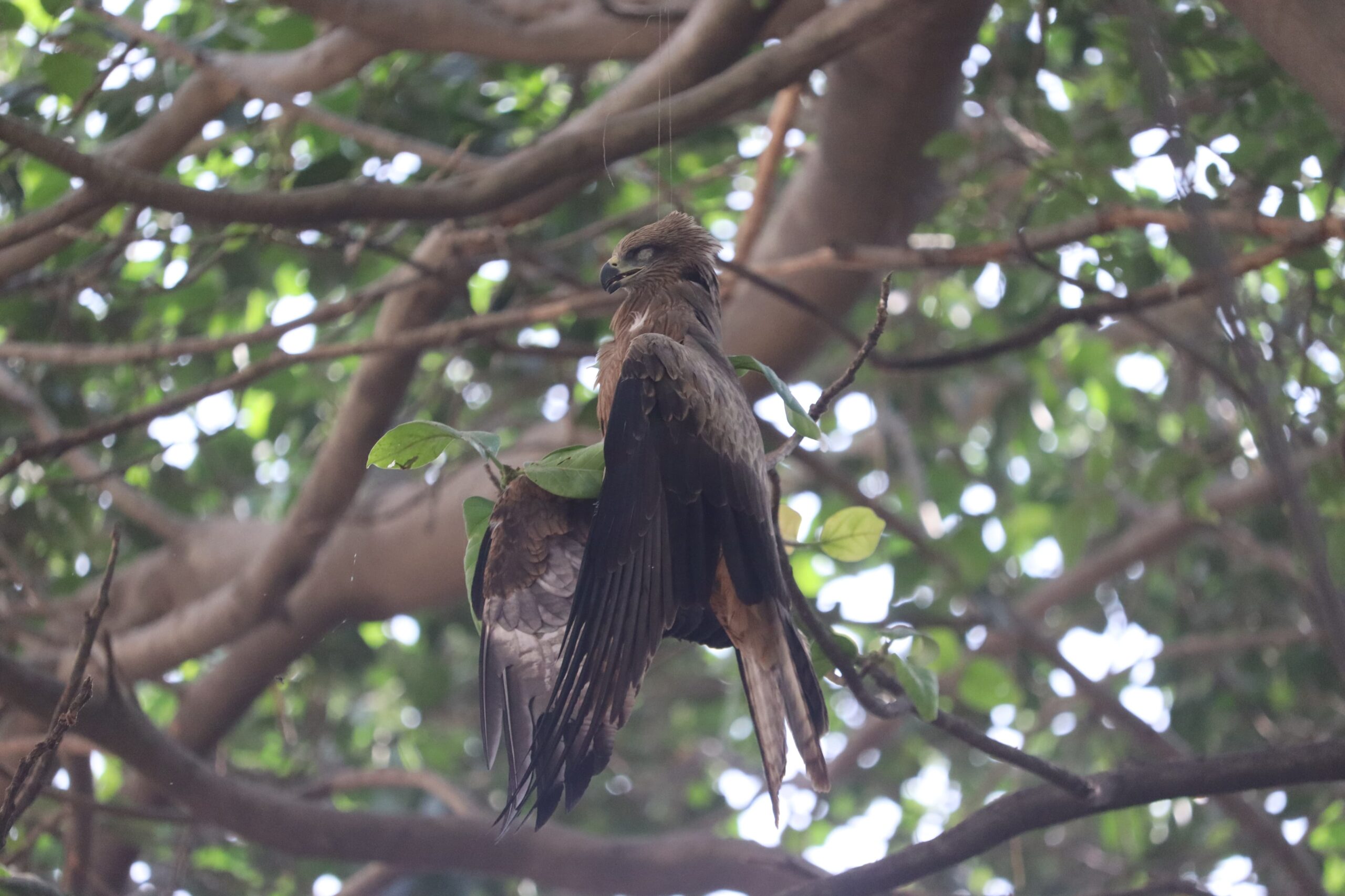Birds getting entangled in Chinese manjha threads survive at most for 48 hours if not traced, rescued, and treated on time.
Published Jan 17, 2024 | 11:00 AM ⚊ Updated Jan 17, 2024 | 11:00 AM

A bird entangled and trapped in Chinese manjha thread
Despite a nationwide ban imposed by the National Green Tribunal in 2017 on the manufacture, distribution, and sale of manjha, it continues to find its way to the market in some way or the other.
This happens especially around the time of Makara Sankranti in mid-January, and it adversely affects the bird population of the urban wildlife.
At least 41 birds have been rescued from 1 to 15 January by the NGO People for Animals (PfA) Hospital from deadly Chinese manjha threads stuck to trees in Bengaluru. That’s nearly three birds every day!
Birds like black kites, Brahminy kites, jungle crows, rose-ringed parakeets, barn owls, peregrine falcons, eagles, lapwings, peafowls, and sarus cranes often fall victim to these deadly glass-coated strings.
Even common birds like crows, pigeons, and sparrows become entangled and trapped in these difficult-to-snap threads.
Birds getting entangled in Chinese manjha threads survive at most for 48 hours if not traced, rescued, and treated on time.
Most of them die out of dehydration and starvation while others die of grave injuries including bleeding and bone fractures.
The injuries the birds suffer are sometimes fatal. They include lacerations, wing injuries, bone fractures, muscle tears, ligament tears, hypothermia, and fluid loss.
“The big birds, upon getting entangled in Chinese manjha, struggle and flap their wings. These big birds are easily noticed by passersby who try and attempt to rescue them, or at least inform People for Animals Hospital volunteers,” PfA General Manager and Chief Veterinary Surgeon Colonel (retd) Navaz Shariff told South First.
“However, small birds like sparrows or parakeets go unnoticed when entangled in these threads at heights of 60-120 feet,” he explained.
“Once a parent bird gets trapped in Chinese manjha, it cannot return to its nest, where it has to feed its babies. Ultimately, all the baby birds also die of starvation,” Shariff told South First.
“Majority of the 41 birds rescued from Chinese manjha by PfA Hospital volunteers are black kites, Brahminy kites, house crows, and jungle crows. There were also a few cuckoos and parakeets,” explained Shariff.
“The number of birds rescued from Chinese manjha last year was around 613,” he added.
“During the Makara Sankranti month (January), the number of rescued birds was 72 in 2023, 17 in 2022, and 26 in 2021,” he said.
Shariff also said that there has been a lack of awareness among students and the youth in Bengaluru on how the banned Chinese manjha has been adversely affecting the bird population. That is why at least 1,400 students from the local schools were invited to the PfA Hospital, where they were educated about the harm that Chinese manjha causes avians,” he said.
“The students are also shown an educational video of the trapped birds, and their rescue and rehabilitation. Upon seeing that video, they vowed not to use Chinese manjha or glass-coated threads ever again,” he said.
Among the 41 birds rescued from the Chinese manjha in the fortnight leading up to Makara Sankranti, many had sustained grievous injuries.
“These entangled birds often bear the brunt of severe injuries, manifesting as flight feather damage, bone fractures, head injuries from falls, and trauma to the neck and legs,” explained Shariff.
“Regrettably, a considerable number succumb to these injuries before we can intervene, while those that do survive face an arduous journey towards recovery,” he added.
Shariff performs a procedure called “impinging” on these rescued birds if their feathers or wings are damaged by Chinese manjha.
“There is a feather bank at the PfA Hospital where feathers of all bird species are collected or harvested. These are ‘impinged’ into the follicles where a bird may have lost its own feather,” he explained.
“It could be from either the wings or from the tail. It could be from the primary wings or the secondary wings. After impinging, the birds are released into the wild overnight. However, in some cases, they have to be kept in rehabilitation until the new feathers grow. With the impinging procedure, when the new feather grows, the impinged feather falls off naturally,” Shariff told South First.
There is a PfA volunteer in the city whose hobby is collecting fallen feathers and harvesting feathers from dead birds.
Gouri Shivayogi collects around 800-1,000 fallen feathers in a month from all the parks near her house in the Vijayanagar area of Bengaluru and gives them to the PfA Hospital’s feather bank.
Shivayogi has also put up Feather Drop Boxes at all the nearby parks, appealing to members of the general public to save a bird’s flight.
A note on the drop boxes states: “Please collect fallen bird feathers from parks, gardens, and rooftops and drop them in the ‘Feather Drop Box’. These feathers will be deposited in the Feather Bank of PfA. At PfA, birds with injured feathers are treated by implanting feathers through the process of ‘impinging’ so that the birds can fly again.”
